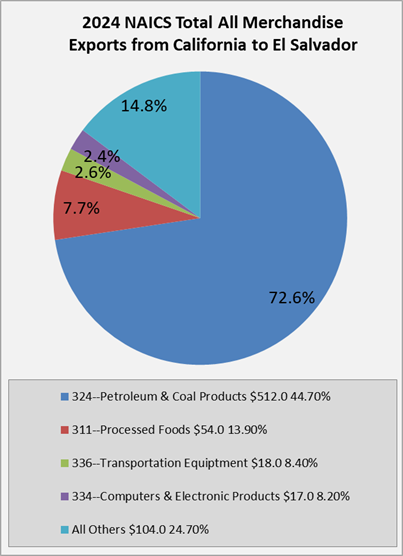Trading Partner Portal: El Salvador
Overview
Trade Overview

El Salvador is a small developing country in Central America approximately equivalent in size to New Jersey. El Salvador, with a population of 6.4 million people, gross domestic product (GDP) of $36 billion, and GDP per capita of $5,607. El Salvador is classified by the World Bank as a lower middle-income country. Though it is a smaller country, El Salvador has a vast array of production. While the majority of the land in El Salvador is used for agricultural production (about 75%), its exports vary from offshore assembly exports, to coffee, sugar, and textiles. World Bank
U.S. – El Salvador Trade

The United States is the top importer of Salvadorian goods and the top exporter to El Salvador. The United States exported just over $5.4 billion worth of commodities to El Salvador in 2024. Many of those products included petroleum and coal products ($1.51 billion), processed foods ($458 million), agricultural products ($324 million), computer and electronic products ($318 million), and chemicals ($288 million).
In 2024, the United States imported around $2.31 billion worth of goods from El Salvador. Top products included apparel and accessories ($1.33 billion) processed foods ($296 million), goods returned ($180 million), agricultural products ($82 million), and transportation equipment ($75 million). US Department of Commerce
El Salvador – California Trade
California exported $716 million of products to El Salvador in 2024. Petroleum and coal products are the main exported good from California, making up $523 million of the total. Other key exports are processed foods ($54 million), transportation equiptment ($18 million), computer & electronic products ($17 million), and chemicals ($15 million).
California is also one of the largest importers of Salvadorian products out of all U.S. states, with a total of $225 million worth of imported goods in 2024. The main imported goods included processed foods ($135 million), apparel and accessories ($37 million), agricultural products ($17 million), reimports ($15 million), waste and scrap ($6 million).
FDI – El Salvador
In 2023, the U.S. invested roughly $1.5 billion in El Salvador. Likewise, El Salvador FDI into the U.S. equaled about $53 billion. US Department of Commerce, BEA
Preliminary Overview of the Economies of Latin America and the Caribbean
ECLAC, December 2019
Trade Agreements
Trade Agreements
Yes, Really: It’s Time to Revive Hemispheric Trade Talks
Latin Trade, August 6, 2020
CAFTA-DR (Dominican Republic- Central America Free Trade Agreement)
The United States trade deal with some of the small developing countries in Central America was signed by President George W. Bush in 2005 as an expansion of the North American Free Trade Agreement. Members of the CAFTA-DR free trade agreement include the United States, Costa Rica, El Salvador, Guatemala, Honduras, Nicaragua, and the Dominican Republic. Exports from the United States to this group of countries totaled $29 billion in 2015, while imports totaled approximately $24 billion. This trade agreement ensures that 100% of goods from the United States are not subject to tariffs in these countries, it also has a goal of phasing out all tariffs on agricultural products by 2020.
Events
Events
Central American Ambassadors Promote Benefits of Trade Agreement with U.S. (03/08/2005)
The California Chamber of Commerce hosted five ambassadors representing the nations included in the proposed U.S.- Central American Free Trade Agreement (CAFTA) at an International Luncheon Forum on March 8, 2005.